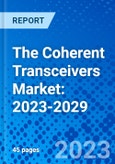In the past few years, the coherent transceivers market has evolved from long-haul and regional networks into data centers and access networks. There is now even talk about coherent PONs, a concept inconceivable a few years back. Work continues towards the specifications that will take coherent communications to the Terabit level.
The breakout of this data is by
- data rate
- range
- MSAs/standards
- network segment in which the transceivers are deployed
As the table of contents below shows, the analysis of the market by network type is especially granular in this report.
The report begins with an analysis of the technological and product-related developments impacting the growth of the coherent transceivers market. This includes various modulation schemes and related integration strategies as well as the impact of the use ROADMs and WDM. The report also provides extended profiles of the leading innovating in the coherent communications space. Coherent technology influencers profiled in this report include OEMs, major transceiver makers and standards/MSA bodies. The report is targeted toward OEMs, transceiver makers, third-party transceiver suppliers, and network managers.
Table of Contents
E.1 Executive Summary
Companies Mentioned
- Ciena
- Cisco-Acacia
- Coherent
- Eoptolink
- Gigalight
- Infinera
- Innolight
- Juniper
- Lumentum
- Nokia








